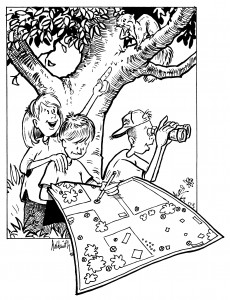Nature Mapping

Originally appears in the Winter 2008-2009 issue
It can be daunting to teach environmental education on some school campuses. Often, the schoolyard is surrounded by little more than a thin line of vegetation or is landscaped with heavily manicured grass and non-native trees and shrubs. Fortunately, nature is dynamic, and even in urban and suburban settings remnants of original habitats can be found in fencerows and stands of coniferous or deciduous trees growing around the campus. Such remnants provide opportunities to research the original habitat and to investigate the species that continue to thrive in the schoolyard. Nature mapping is a valuable tool for these activities, as it not only provides a reason for exploration but also encourages students to complete the “blank spots,” to seek out places they have not yet explored.
Beginning to map
As a starting point for mapping, I ask students to map as many features of the schoolyard as they can remember and to create their own legend to these features. This can be done either individually or in groups, depending on the age and number of students. With students under 12 years of age, I usually draw a map on the board and let them fill in the details. I then have them draw a copy of this map to the best of their ability. This form of mapping is like a memory game: it pushes students to the edge of their knowledge, drawing their mind’s eye to details they have grasped through everyday experience of their surroundings. It is enough at this point to provide paper, pencils, erasers, markers and crayons. Leaving out rulers allows for a more artistic course and enables students to focus on the flow of knowledge without worrying about such details as which building is larger. Even with older children (12 years and up), I encourage free-form mapping before introducing the concepts of scale and orientation (which are excellent for incorporating math skills). I also have students compare their maps. Research shows that age and cognitive development determine perception and mapping ability. By viewing each other’s maps, they can gain understanding that there is more than one way to perceive and interpret the world around them.
This content is restricted to subscribers only.
If you are not yet a subscriber, please consider taking out a subscription here.
If you are an existing subscriber, kindly log in or contact us at info@greenteacher.com for more information.





